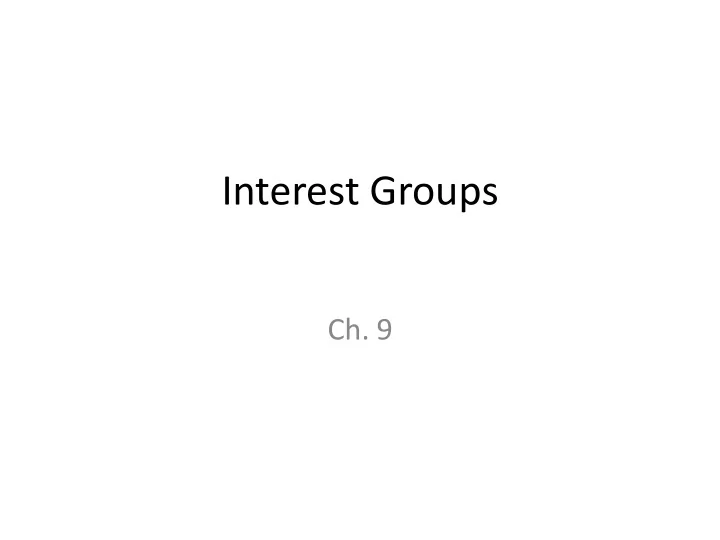

Interest Groups Ch. 9
• Fun facts: – 64% of Americans believe “the government is run for the benefit of a few big interests” – 39% of Americans believe “special interests” are what’s most wrong with the government today
• Americans have always been suspicious of “special interest politics” – All the way back to Madison and factions
• Madison’s view is based on one big assumption: – There is a NATIONAL INTEREST – This makes any group working against the needs of the nation a real problem
BUT: • What if that assumption is wrong? • Challenge: – Any student who comes with a policy or law that’s to everyone’s advantage gets an A in this class. – Seriously.
• Here’s the problem: – In a large, diverse country, different interests ALWAYS conflict – It’s hard to speak of the “public interest” if there’s not really one “public” • Ex: South Carolina & Myrtle Beach bike week
• Madison was right about: – Democracy & freedom making group activity inevitable – Pursuit of self-interest being divisive – Government’s structure can limit the power of “factions”
• Difference between interest groups & parties: – Political parties try to control the government • Get their members elected to office – Interest groups try to influence the government • This process is called lobbying
• Interest groups & lobbying exist at all levels of government: – National -> NRA, MADD, ACLU – State -> SC Chamber of Commerce, SCEA – Local -> Florence Chamber of Commerce • Neighborhood associations • School boosters • Arts associations
• Interest groups & political parties are similar – Both are linkage institutions • Def: Organizations that exist to connect individuals to the government
OUTPUT INPUT GOVERNMENT FEEDBACK
• On the input side, groups provide: – Political information and technical information • Political information involves the “politics” of an issue – Duh. – 2 types: 1. The scope of the issue 2. The salience of the issue
Pluralism • Opposite Madison, some people came to believe: – Interest groups might play a positive role – Shouldn’t tear the country apart
• Why do groups form? – Change! Social, economic, and political. • Change is disruptive! • Ex: Horses vs. cars
• To pluralists: – People who have “suffered” because of changes form groups – They ask the gov’t for help with problems • Ex: Women’s rights, civil rights
• In their view, Madison was wrong about almost everything – Things are always changing – So, there are always new winners and losers – New groups are constantly emerging
• This is ultimately a benefit! • In the long term: – One group’s needs get met – The “balance” might tip too far – New groups challenge them
Problem • Why isn’t everyone represented? • If pluralists are right, the least fortunate have the most incentive to organize – But we don’t see groups of the homeless, teenage mothers, drug addicts
Not quite. • Difference between incentive to organize and the ability to organize. – Homeless people might need help, but might not be very good at organizing to get it
Critique of Pluralism • Economists argued: – Groups don’t “just form” • Somebody has to start them – Used ideas about business to explain group formation
• Businesses are started by entrepreneurs – Def: an individual who uses her own resources to bring a product to the market – Motive = profit – Risk = failure, loss of investment
• “Interest group entrepreneurs” try to get people to buy membership in the group • Problem: buying a group membership is different from buying something like a car – Private vs. collective (public) goods
• Ex: – Organization for Moms Financing underGrads (OMFG) – $30 / year for membership – Group wants $4000 tax credit for tuition • Whether or not the group is successful, you are better off NOT JOINING
• That’s the free-rider problem from chapter 1 • Interest group leaders must get past the free rider problem to be successful – How? – Must provide selective incentives • Extra benefits to people who join group
• A skilled entrepreneur finds selective incentives that appeal to potential members – One who’s really good could find benefits that get people to join even if they disagree with the group’s purpose • Seriously. • I bet at least 2 of you belong to a group that:
• Lobbies for less safe cars – AND- • More pollution
• People don’t join AAA because they love smog – The services are so good – Members might not even realize the group lobbies • That’s slick
National Rifle Association • Membership costs $27 / year – Benefits: • Choice of 4 magazine subscriptions • $10,000 life insurance • $1,000 firearms insurance • Hotel / rental car discounts • Prescription drug plan • Discounted LASIK surgery – Pretty good bargain
• Problem: – Money spent on selective incentives is money that can’t be spent on lobbying – Most groups are on limited budgets • Solution: – Find incentives that are appealing AND cheap!
3 Types of Selective Incentives 1. Material incentives – Actual “stuff” 2. Purposive incentives – Satisfaction from helping a “worthy cause” 3. Solidary incentives – Networking, companionship, social benefits
Recommend
More recommend